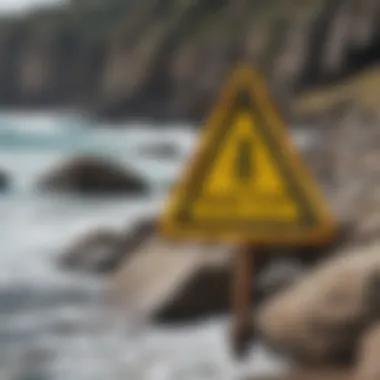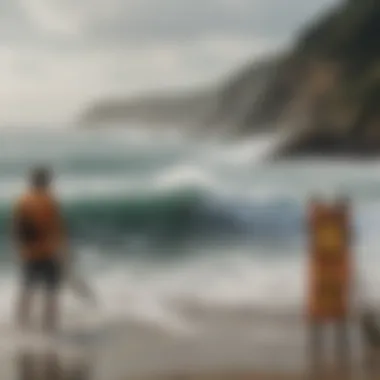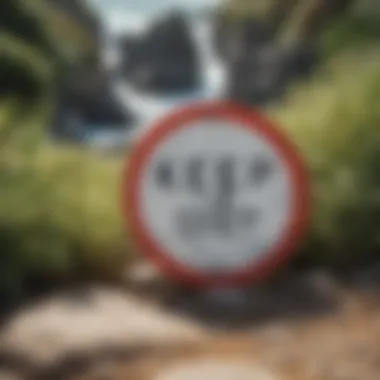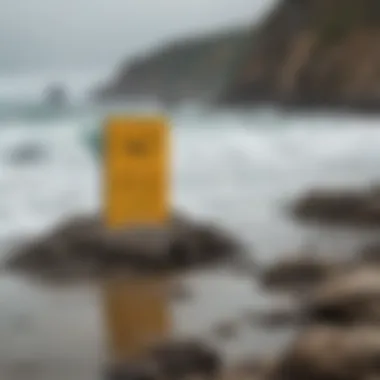Coastal Safety: The Role of 'Keep Off Rocks' Signs


Intro
Beach days conjure images of golden sands and rolling waves, but lurking beneath the surface are dangers that can turn a dream getaway into a nightmare. One significant threat comes from rocky shorelines, where the beauty of nature meets the harsh reality of its perils. Within this context, 'Keep Off Rocks' signs become more than just ordinary warnings; they serve as crucial reminders of the risks surf and beach enthusiasts face.
The purpose behind these signs isn’t simply to spoil a good time; it is to protect individuals from the unpredictable nature of coastal environments. From slippery surfaces to sudden waves crashing against the rocks, ignoring these signs can lead to severe injuries, sometimes even fatalities. It’s essential for surfers and beachgoers alike to understand the necessity of these warnings, not only for personal safety but also for the preservation of the delicate ecosystems that thrive along the coasts.
Exploring the importance of these signs requires a closer look at the common hazards present on rocky shorelines. As waves crash and retreat, they can create precarious conditions that make safe navigation increasingly challenging. So, let’s delve deeper into this vital topic and uncover what it truly means to respect these signs.
Prolusion to Coastal Signage
Coastal signage serves as a fundamental part of ensuring safety for those who enjoy the seaside, especially around rocky areas where the risks of injury can be significant. These signs do not just exist for decorative purposes; they are critical warnings designed to protect individuals from the potential dangers presented by the dynamic coastal environment. Understanding what these signs convey can make the difference between a safe outing and a hazardous encounter.
In the context of coastal safety, the importance of signs like "Keep Off Rocks" cannot be overstated. They act as sentinels, guiding surfers, beachgoers, and fishermen alike, providing essential information that can prevent accidents. The benefits of adhering to these messages extend beyond personal safety to encompass the conservation of fragile marine ecosystems.
Defining Coastal Safety Signs
Coastal safety signs act as pivotal indicators of potential hazards, especially in areas where natural landscapes can be dramatically unforgiving. These signs typically include warning symbols, clear text, and color codes that denote seriousness. For instance, a sign reading "Danger: Rocky Shore" in bright colors is meant to draw immediate attention.
What many do not realize is that these signs also provide insight into local conditions that can vary based on tides, weather, and even seasonal changes. Each sign is often tailored to the specificities of the location, indicating not only danger but also informing beachgoers about the local ecosystem and its vulnerabilities.
Purpose of 'Keep Off Rocks' Signs
The purpose of the 'Keep Off Rocks' signs stands as a crucial part of coastal safety. They aim to deter individuals from venturing onto areas that are not only dangerous due to slippery surfaces but also due to the unpredictable nature of the waves crashing on rock formations. The rocks can serve as traps if the tide unexpectedly rises, creating conditions where escape can be challenging.
Moreover, these signs also hint at the ecological health of the coastal region. By encouraging individuals to stay off these formations, they are helping to protect marine life that relies on those habitats. Coastal areas are often home to delicate ecosystems, such as tide pools, where specific species thrive. Interference from human activity can disrupt these populations, impacting the overall health of marine biodiversity.
"A sign is more than just a reminder; it’s a bridge to understanding the natural world and our place within it."
In summary, coastal signage, particularly warnings like 'Keep Off Rocks,' plays an indispensable role in promoting safety and environmental stewardship. Ignoring these warnings can lead not only to personal injury but also to environmental degradation. As the tides ebb and flow, so too does the need for deeper understanding and respect for the environments we often take for granted.
Understanding Coastal Hazards
In coastal environments, the breathtaking beauty can lure many, from surfers chasing waves to families having picnics on sandy beaches. However, the coastline holds dangers that an unknowing visitor might easily overlook. Thus, understanding coastal hazards is vital for anyone who steps onto this unpredictable terrain, especially in areas marked by rocky outcroppings. Recognizing these hazards not only helps ensure personal safety but also aids in preserving the delicate balance of coastal ecosystems.
Identifying Rocky Shoreline Risks
Rocky shorelines can be both stunning and treacherous. The risks associated with these rugged landscapes are numerous. For instance, strong currents and sudden wave actions can easily catch a casual beachgoer off guard, leading to slips and falls on wet rocks, or worse, being swept out into deeper waters. It’s important to remember that the beauty of nature doesn’t always come without its pitfalls.
Knowing the specific risks involves observation and education. Familiarizing oneself with local conditions, such as tide levels and wave patterns, contributes to better decision-making. Certain areas might be prone to unpredictable tides that can turn a calm day into chaos. Visitors should also remain aware of how rocky formations can obscure underwater hazards, which often hide beneath the surface and pose a serious danger to swimmers or surfers.
Taking a moment to heed nearby signage helps gauge whether a certain area is deemed safe for activities. The signs that read "Keep Off Rocks" serve as crucial warnings, highlighting areas** where the danger is particularly heightened**.
Natural and Man-Made Dangers
When it comes to coastal hazards, both natural and man-made factors deserve consideration. Natural obstacles like slippery algae or barnacle-encrusted rocks can create unforgiving conditions for anyone who isn’t cautious. Coastal areas are also subjected to weather changes that can exacerbate risks, such as rogue waves or sudden storms, often catching beachgoers unaware.
On the flip side, man-made structures can represent significant hazards too. Abandoned piers, broken jet skis, or even constructions designed for fishing can create a false sense of security, hiding dangers underneath their surfaces. Furthermore, some coastal areas may include remnants of pollution, such as debris from previous storms or litter left behind by careless visitors. This detritus not only disrupts the natural beauty of coastal areas but can also introduce harmful elements to marine life and the ecosystem as a whole.
Legal Aspects of Signage
When discussing coastal safety, it’s vital to explore the legal aspects of signage. These components not only shape the framework for how warnings like "Keep Off Rocks" are constructed and enforced but also clarify the responsibilities that both users and authorities carry. Understanding these legal dynamics is essential not just for safety, but also for protecting the interests of all parties involved.


Liability and Responsibility
Liability surrounding coastal signage often involves a complex interplay of state and local laws. Authorities are charged with the responsibility of ensuring that all safety signs are clear, visible, and strategically placed to maximize comprehension. Signs must effectively communicate risks associated with rocky shorelines, and the failure to do so can result in significant legal consequences. For surfers and beachgoers, awareness of these regulations can not only increase their safety but also protect them from potential liability in the event of accidents.
On the flip side, individual responsibility becomes equally significant. Beach enthusiasts should take it upon themselves to heed the warnings provided. Ignorance of a sign, especially one that specifically states "Keep Off Rocks", does not absolve one from the repercussions of an injury sustained in a prohibited area. This legal doctrine of personal responsibility reinforces the idea that safety is a shared endeavor. For example, if a surfer chooses to ignore these warnings and subsequently gets injured, they may find it challenging to seek damages if the area was expressly marked for caution. Thus, staying within the bounds of legal signage is not just a matter of compliance, but rather a crucial aspect of personal liability and safety awareness.
Regulation of Coastal Signage
Regulation of coastal signage is often dictated by both local environmental statutes and coastal management policies. Regulatory frameworks typically set out guidelines for design, placement, and maintenance of these critical signs. It’s important to note that such regulations can vary significantly from one region to another, depending largely on the local geography and ecological contexts. In some areas, for example, signs may be required to include multilingual instructions to cater to diverse communities.
Moreover, proper maintenance is essential to ensure the longevity and effectiveness of these signs. Faded or damaged signs not only compromise safety but can also invoke liability for the parties responsible for their upkeep. Authorities must perform regular checks to ensure that the signs communicate risks effectively and conform to current regulations.
In essence, the regulation of coastal signage is not just a matter of putting up a post on a beach. It involves a meticulous process that encompasses planning, community feedback, and ongoing assessment. By doing so, coastal managers not only safeguard both the natural environment and the users who frequent these areas, but they also bolster a culture of respect toward safety practices that can help mitigate risk.
Understanding the legal aspects of signage is crucial for both surfers and coastal authorities; it bridges the gap between awareness and action, ensuring everyone plays a role in fostering a safer coastal experience.
Through a comprehensive grasp of these legal elements, beachgoers can navigate coastal environments with a more informed perspective on safety signs and their implications.
Impact on Surfing and Coastal Activities
Understanding the impact of coastal safety signage, particularly ‘Keep Off Rocks’ signs, is paramount for those who immerse themselves in surfing and other coastal activities. These signs are more than mere recommendations; they serve as critical warnings that contribute significantly to personal and environmental safety. Recognizing their importance aids in fostering a culture of mindfulness among beachgoers and surfers alike.
Surfing Near Rocky Areas
The thrill of riding waves can lure even the most cautious surfers towards rocky shorelines. However, this allure is often accompanied by significant risks.
- Natural Hazards: Rocky areas can hide sharp underwater formations, increasing the chance for serious injuries. A mishap can lead not only to cuts and bruises but also more severe repercussions like head injuries or lacerations.
- Wave Dynamics: The interaction between waves and rocks creates unpredictable surf conditions. Surfers may face sudden riptides or waves that break erratically, all of which heightens the danger.
- Environmental Awareness: Signs urging surfers to keep off the rocks also promote respect for the coastal ecosystem. Navigational care helps maintain the biodiversity of rocky habitats, which thrive in such delicate environments. Being aware of the potential dangers paves the way for smarter surfing choices.
It’s essential for surfers to digest these warnings and embrace safer surfing habits. Many seasoned surfers will tell you firsthand the importance of understanding the conditions around rocky stretches—knowledge can mean the difference between enjoyment and tragedy.
Recreational Use of Beaches
Beach activities are as varied and rich as the many visitors that frequent them. From picnicking to fishing, these coastal offerings create a vibrant community experience.
- Family Safety: Parents often take their children beaching without full awareness of surrounding hazards. ‘Keep Off Rocks’ signs aim to protect not just surfers but everyone who enjoys the beach. Ignoring those signs can turn a fun day into an unfortunate accident.
- Community Respect: Following these signs fosters a peer emphasis on safety and cooperation among beach enthusiasts. Encouragement from one beachgoer to another about adhering to set guidelines can elevate overall community awareness.
- Preservation of Natural Spaces: Recreational use must balance enjoyment and environmental stewardship. Coastal regions are not just playgrounds; they encompass fragile ecosystems where ignoring signage can lead to irreversible damage. Understanding and respecting these signs contributes towards maintaining the beauty and sanctity of the coastal area.
"The beach is a shared space, and the rocks are often a silent reminder of nature’s power. Respecting these boundaries maintains harmony for everyone."
By actively promoting adherence to 'Keep Off Rocks' signage, surfers and beachgoers alike can help create a safer and more enjoyable environment. Ultimately, such awareness is not only an individual responsibility but a communal one, fostering a spirit of cooperation within coastal communities.
Community Awareness and Engagement
Engaging the community about coastal safety is crucial for transforming how people interact with rocky shorelines. When beachgoers and locals are made aware of the dangers lurking just a few meters away from that stunning view, the potential for accidents can significantly decrease.
Understanding the cultural and ecological significance of coastal areas helps emphasize the need for safety signs like Keep Off Rocks. It’s not just about protecting individuals; it’s about nurturing a culture of respect for the natural environment. When people actively participate in safety initiatives, they often adopt more cautious behaviors while enjoying their activities. Awareness campaigns foster this mindset, ensuring individuals recognize that those rocks may seem harmless but can conceal dangers, like sharp edges and slippery surfaces.
Benefits of Community Engagement
- Enhanced Awareness: Communities better understand the threats linked to these areas, promoting safety.
- Shared Responsibility: When engaging with one another, residents and visitors cultivate a shared sense of responsibility towards maintaining safety along the coast.
- Increased Compliance: Educated beachgoers are more likely to follow signage guidelines since they grasp their significance.
Educating Beachgoers


Education is the backbone of fostering safe beach practices. Workshops, seminars, and informal gatherings can serve as platforms to update the community on the rationale behind safety signages, such as Keep Off Rocks.
Utilizing local influencers to reach out to the surfing community is also effective. When well-known surfers share personal experiences and the importance of adhering to warnings, fellow surfers are likely to take notice.
Informational materials, like brochures or social media posts, can graphically illustrate the kind of dangers posed by rocky areas. Visual aids complement verbal communication and make the message more lasting. Moreover, strategically placed posts at beaches reinforce the significance of these warnings.
Local Initiatives for Safety
Community-led initiatives can significantly amplify outreach efforts. Organizations can partner with local governments and stakeholders to develop programs focusing on safety around rocky shores.
These initiatives can take various forms, including:
- Beach Clean-Ups: Organizing clean-up events that also incorporate discussions about coastal safety allows for firsthand experience of the area's risks.
- Safety Days: Hosting dedicated days where experts share information on navigating rocky areas safely attracts families, making it an enjoyable learning experience.
- Social Media Campaigns: Engaging local online platforms to disseminate safety messages can reach wider audiences, especially younger generations.
"What we do today is a reflection of what we want our coastlines to be tomorrow."
Focusing on community engagement reinforces the collective effort needed to ensure safety at the coast. When locals and visitors embrace the importance of safety signs collectively, that shared understanding can lead to more vigilant behavior, ultimately preserving both lives and ecosystems.
Environmental Considerations
In coastal areas, the relationship between safety signage and environmental conservation is a critical one. 'Keep Off Rocks' signs serve not only as warnings for personal safety but also as a reminder of our responsibility toward protecting vulnerable ecosystems. Understanding the environmental implications of these signs allows beachgoers and surfers to navigate the coastal landscape with a heightened sense of respect for nature.
Ecosystem Protection
The rocky shorelines are often home to a diverse range of ecosystems. Small tidal pools, algae-draped rocks, and various marine life flourish in these areas. Each rocky outcrop may host specific species, from crabs to anemones, which play integral roles in their ecosystems. By adhering to signs urging individuals to keep off the rocks, we help preserve these habitats from the strain of foot traffic and disturbances.
The erosion of these areas from excessive human interaction can lead to long-term damage. When people disregard warning signs, the biodiversity at these sites can diminish. This is especially true for delicate species that are unable to recover from repetitive stress.
"Protecting our marine ecosystems is not just an act of goodwill but a necessity for our planet's health."
Benefits of Ecosystem Protection:
- Biodiversity Preservation: Keeping rocky areas untouched ensures that various species can thrive without interruption.
- Natural Balance: Healthy ecosystems help maintain a balance that can benefit both marine life and humans.
- Aesthetic Value: Pristine rocky shorelines contribute to the beauty of the coast, drawing tourists and nature lovers alike.
Respecting Marine Life
Respecting marine life extends beyond simply observing it from a distance. The message behind 'Keep Off Rocks' signs conveys a deeper principle: coexistence with nature. Our actions can significantly impact marine life, from coral reefs to small fish habitats. When individuals stay away from sensitive areas, marine ecosystems have a better chance to flourish.
Awareness and education regarding local wildlife can also foster a culture of respect. Recognizing what lies beneath the surface can deepen one's appreciation for coastal environments. Understanding the delicate balance of life that exists on and around the rocks encourages informed behaviors in beach visitors, surf enthusiasts, and local communities.
Cultural Significance of Coastal Areas
The coastal zones are not only the backdrops for summer vacations or surfing adventures; they bear a rich cultural significance that shapes local identities and lifestyles. From the stories passed down through generations to the development of community ties, coastal areas play a pivotal role in many societies. These landscapes invite residents and visitors alike to reflect on their unique values, traditions, and the delicate balance between enjoying these beautiful spaces and preserving them.
Historical Context of Coastal Usage
Coastal usage dates back centuries, intertwined with the history of human civilization. Historically, communities have settled near coastlines for various practical reasons. Access to the bounties of the sea, such as fish and other marine resources, was crucial for survival. Many cultures have relied heavily on coastal fishing, cultivating a respect for marine life that informs their practices even today.
In places like Japan, the connection to the sea has deep historic roots, influencing festivals and rituals, while the harbors of Mediterranean towns have been meeting points for trade and exchange. Artistic expressions, from literature to visual arts, often draw from the coastal landscape — melding personal narratives with environmental consciousness.
"The coast is not just a scenic vista; it's a canvas of our collective histories, etched by the waves of time."


This historical context illuminates why modern coastal usage must be approached with care. As today's beachgoers and surfers bask in the sun or ride the waves, the stories of those who came before them should not be overlooked. They serve as reminders of the responsibility to respect and protect these areas to preserve their cultural richness.
The Role of Surfing in Coastal Communities
Surfing is not just a sport; it is an integral thread in the cultural fabric of many coastal communities. In places like Hawaii, surfing transcends mere recreation; it is a fundamental aspect of the local identity and heritage. The Hawaiian word "He'e nalu" embodies not just riding waves but also reflects a deep connection to the ocean, infused with spirituality and tradition.
In addition to fostering community pride, surfing promotes local economies. Coastal towns often thrive on surf tourism, where visitors flock to catch waves, enjoy beach culture, and engage with local vendors. This interaction enhances a sense of belonging for both surfers and residents.
Furthermore, surfing communities are often at the forefront of environmental advocacy, championing efforts to protect the coastlines they so dearly love. Their initiatives—whether through organized beach clean-ups or lobbying for sustainable practices—reveal a profound respect for both nature and culture.
This interplay between surfing and coastal life underscores how vital these areas are. It underscores the need to uphold the messages of signs like "Keep Off Rocks," which ensure not only individual safety but also the preservation of a heritage intertwined with the ever-changing tides.
Best Practices for Coastal Safety
When it comes to coastal safety, especially concerning rocky areas, adhering to established practices is paramount. Best practices not only protect individuals but also contribute to the ongoing preservation of natural settings. Understanding the relevant steps can help beachgoers and surfers enjoy their time by the water without unnecessary risks.
Signage plays a vital role in these best practices. Specifically, signs like "Keep Off Rocks" serve as both warnings and guidelines that instill a necessary caution in visitors. It's essential to recognize that ignoring these signals often leads to accidents and injuries, not just for the individual but potentially for those around them as well.
Following Signage Guidelines
Observing signage guidelines is the bedrock of ensuring safety along the coastlines. These signs are strategically placed to highlight areas that pose potential dangers, usually based on comprehensive assessments of local geography and hazard analysis. While some might see them as mere suggestions, they actually stem from well-founded knowledge about the risks associated with rocky shorelines.
- Stay informed: It is crucial to familiarize yourself with the specific warnings around the beach you visit. Each location has unique conditions that can change swiftly, from tides to weather.
- Be observant: Many signs carry additional information, such as the type of dangers to expect. Whether it’s sharp rocks, strong currents, or unpredictable waves, keeping an eye out for these specifics can make all the difference.
- Use technology wisely: Smartphone applications and websites, such as reddit.com and local surf reports, can provide real-time information about conditions at the beach, making your decision-making more informed.
Ignoring those guidelines could not only disrupt your own enjoyment but pose risks to others enjoying the coastal environment. The simple act of being attentive to these markers fosters a sense of community responsibility and enhances everyone’s safety.
Personal Responsibility as Beach Users
Engaging in coastal activities comes with inherent risks. It’s the personal responsibility of each user, whether they’re surfing, beachcombing, or just enjoying a day in the sun, to recognize and act on their surroundings. Just knowing the "Keep Off Rocks" signs is not enough; taking proactive steps can significantly enhance safety for everyone.
- Educate yourself: Before hitting the waves or even exploring the shoreline, it’s helpful to learn about the specific characteristics of the local area. Resources like britannica.com can provide insights into coastal ecology and regional hazards.
- Respect the environment: Beyond personal safety, there's the broader implication of respecting flora and fauna. Avoiding rocky areas does not just mean steering clear of injury; it also protects sensitive ecosystems that are often impacted by foot traffic.
- Lead by example: When you demonstrate responsible behavior, others are likely to follow suit. Whether it’s guiding kids away from hazardous zones or engaging with peers about risks, your actions can create a safer recreational culture.
Taking charge of personal responsibilities ensures that everyone can enjoy the coastal spaces. Recognizing the situation as a shared environment enhances the sense of community; calling on each beachgoer to play their part contributes to a safer and more enjoyable experience.
Ultimately, safety at the coast boils down to remaining vigilant—adhering to signage, respecting guidelines, and fostering a culture of accountability.
As you engage in surfing or simply soaking in the beach vibe, remember the importance of these best practices in preserving not only your own well-being but that of the entire community.
End: Upholding Coastal Safety
In this piece, we have journeyed through the vital role 'Keep Off Rocks' signs play in ensuring both personal safety and the conservation of coastal ecosystems. Addressing various elements, we can see that the preservation of life on the rugged shorelines is not just about avoiding injuries; it's about developing a culture of respect for nature's boundaries.
Reinforcing the Importance of Caution
Caution is a cornerstone of coastal safety. When adventurers approach a rocky shoreline, it's easy to get lost in the thrill of the waves or the allure of a perfect surfing spot. However, we must remember that caution lights the path to safety. The thrilling waves may often crash against perilous rocks, creating hazardous scenarios for both novices and seasoned surfers.
Beyond the obvious dangers of slips, falls, or severe injuries, there's a more subtle aspect to consider. Children running along the beach, not fully aware of their surroundings, can easily find themselves in hazardous zones. Educating the public, particularly beachgoers, about the significance of these signs fosters a greater respect for safety. Resources such as local surf schools and community organizations can amplify this message, emphasizing the necessity of adhering to safety signage.
"Safety isn't just a guideline; it's the very foundation upon which we enjoy our coastal experiences."
Encouraging Responsible Beach Practices
Promoting responsible beach practices goes hand in hand with caution. Use of signage, such as 'Keep Off Rocks', should not merely be a sticker on a post; it should spark conversations among surfers, beachgoers, and local communities. Adopting a proactive stance nurtures a culture of caution and respect.
There are several practices individuals can adopt to ensure a safer coastal experience:
- Stay Informed: Understanding warning signs and local conditions is paramount. Read the notice boards provided at beaches. They contain vital information that might impact your enjoyment.
- Engage in Local Outreach: Participate in community awareness campaigns. Many areas run programs focused on educating the public about coastal hazards and how to navigate them safely.
- Buddy System: While surfing or exploring rocky areas, never venture out alone. Having a companion not only enhances safety but also allows for shared experiences and decision-making.
- Respect Wildlife: Many rocky areas are habitats for diverse marine species. Be conscious of where you tread to avoid disturbing these delicate ecosystems.
Employing these methods can help bridge the gap between enjoyment and safety, ensuring both aspects coexist harmoniously.















